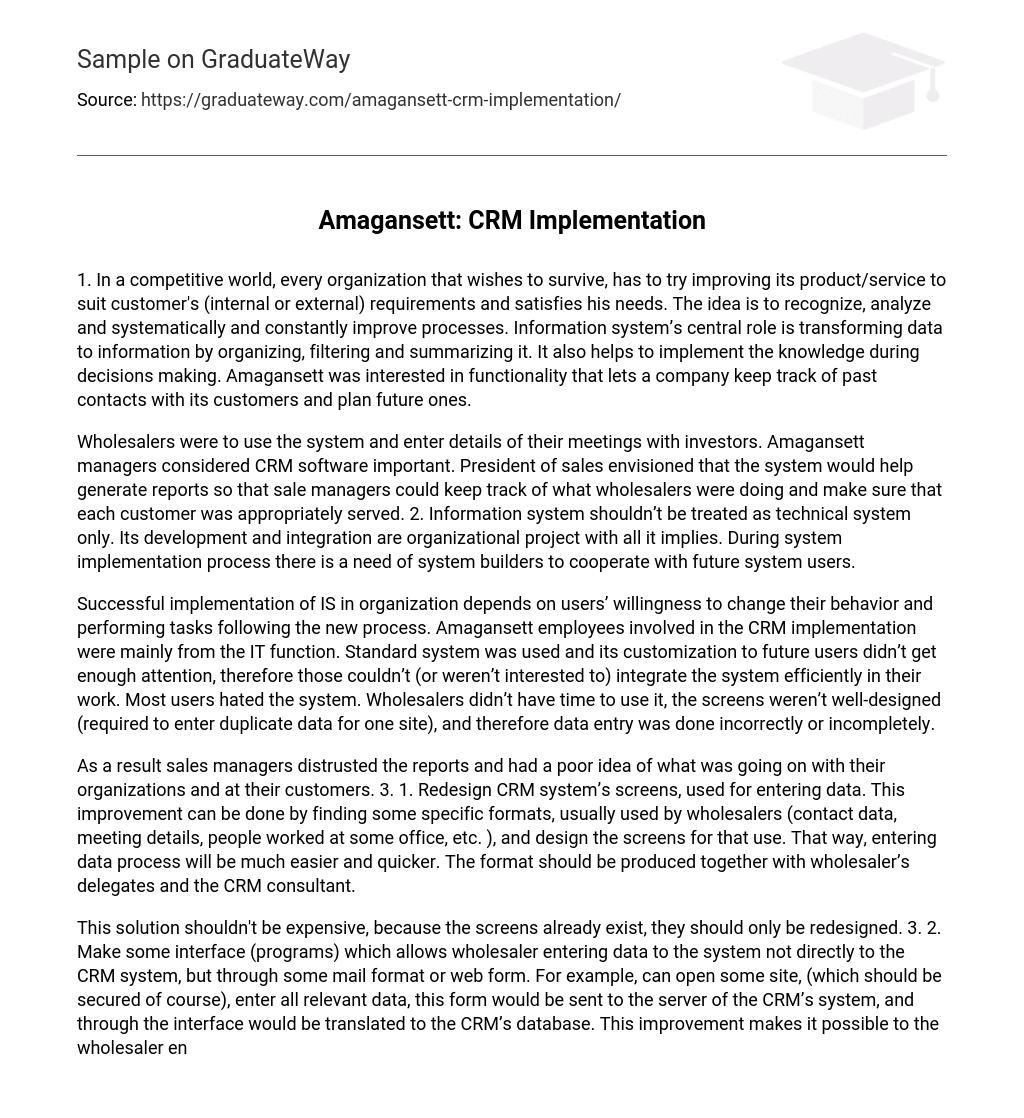In a competitive world, every organization must strive to improve its product/service to meet the needs of its customers. This involves recognizing, analyzing, and continuously improving processes. The central role of an information system is to transform data into organized, filtered, and summarized information. It also assists in decision-making by implementing knowledge. Amagansett desired functionality that would enable a company to track past customer contacts and plan future ones.
Wholesalers were instructed to utilize the system by inputting information about their meetings with investors. The importance of CRM software was recognized by Amagansett managers. The president of sales had a vision for the system to generate reports in order for sales managers to monitor the activities of wholesalers and ensure that each customer received proper attention. Additionally, it is worth considering that the information system is not just a technical element, but rather an organizational project that involves development and integration. Consequently, during the implementation process, it is necessary for system builders to collaborate with future system users.
The successful implementation of IS in an organization depends on user willingness to change behavior and perform tasks according to the new process. At Amagansett, CRM implementation involved primarily IT employees, but customization for future users was not adequately addressed. As a result, these users were unable to effectively integrate the system or lacked interest in doing so. The majority of users strongly disliked the system. Wholesalers faced time constraints that hindered proper utilization and poorly designed screens necessitated duplicate data entry for each site. Consequently, data entry was frequently incorrect or incomplete.
Sales managers lacked trust in the reports and had limited insight into the activities of their organizations and customers. To address this, the CRM system’s screens used for data entry should be redesigned. This can be achieved by incorporating specific formats commonly used by wholesalers, such as contact information, meeting details, and personnel records. The design of these screens should be collaborated on with wholesaler representatives and the CRM consultant. Implementing this improvement will streamline the data entry process, making it faster and more efficient.
The screens for this solution already exist and only need to be redesigned, so it shouldn’t be expensive. An interface (programs) can be created to allow the wholesaler to enter data into the system indirectly, either through a mail format or web form. For example, they can access a secure website, enter all the relevant data into a form, which would then be sent to the CRM system’s server. The interface would then translate this data and store it in the CRM’s database. This improvement allows the wholesaler to enter data into the system almost in real-time, very soon after the contact is made.
One significant result of this solution is the extension and improvement of data accuracy. Moreover, it offers flexibility as it can be applied to different devices including laptops, palms, and smartphones. Cost-effectiveness is also a benefit since the web form can be made simple and the interface easily converts data to the desired format on the CRM’s database. Another approach for wholesalers to enter information while on the go is by delegating the task to someone else like a secretary. This is because wholesalers are often traveling and meeting with clients rather than being situated in an office.
The wholesaler can communicate with the secretary by phone or leaving a voice message. They can provide all the necessary data, which the secretary will then enter into the CRM system. This ensures that all details are entered accurately and nothing is missed. Implementing this solution requires training secretaries to use the system and potentially hiring more personnel. However, it is a cost-effective option. Additionally, the availability of devices like the iPad revolutionizes our analysis. With such technology, every system can be accessed online. The iPad eliminates concerns about size and weight, which was previously mentioned in relation to laptops.
The system can be installed on an iPad, allowing everyone to enter data almost online, closely following the time of the meeting. If there is no web connection, the data will be saved locally on the iPad and synchronized when connected to a computer with a CRM system connection. In case data is needed, it can be quickly obtained from the system and saved locally on the iPad for future easy and fast access. However, to ensure usability and convenience, the system should be designed in collaboration with wholesalers.





